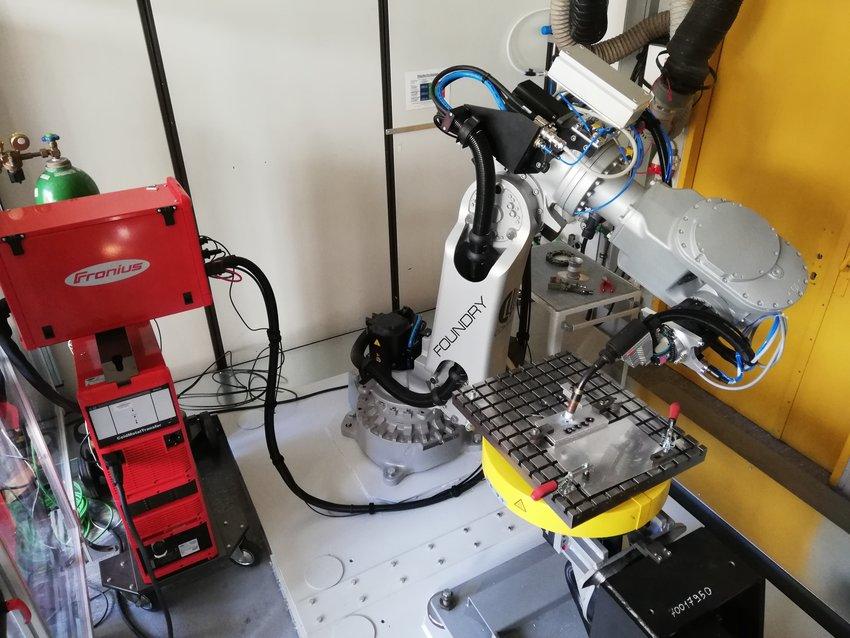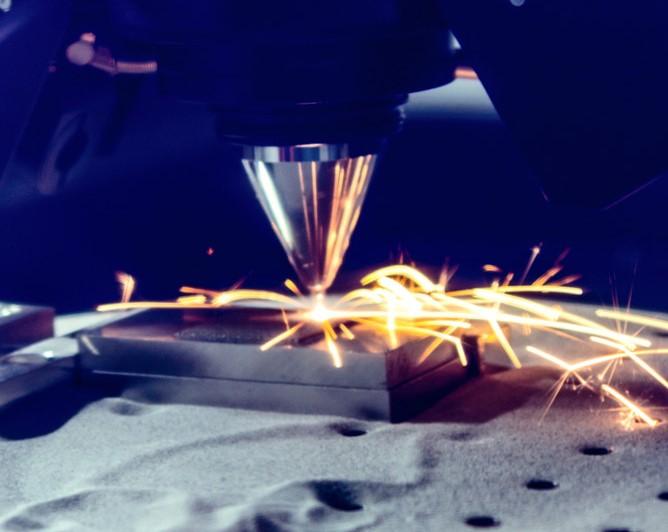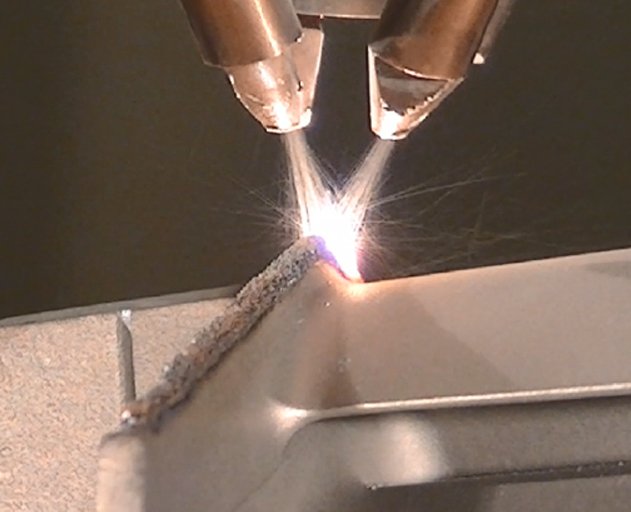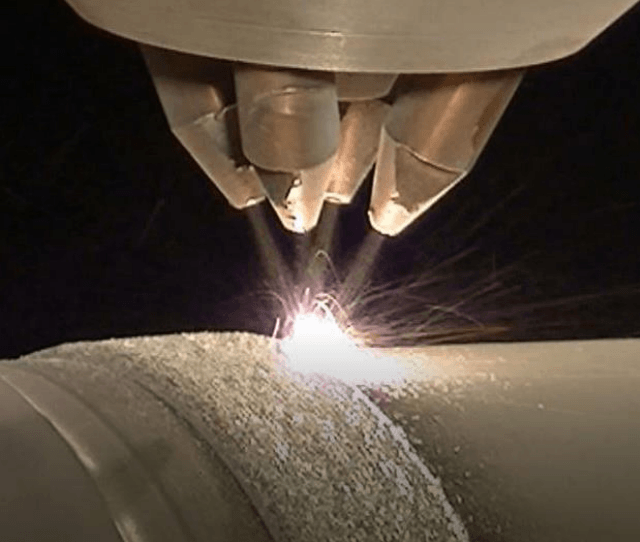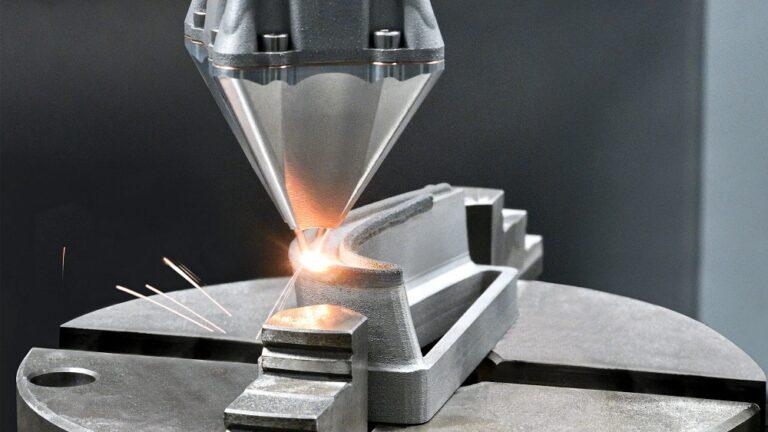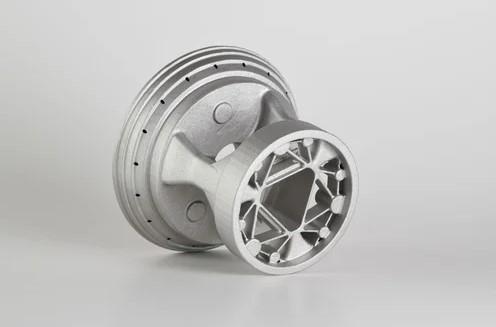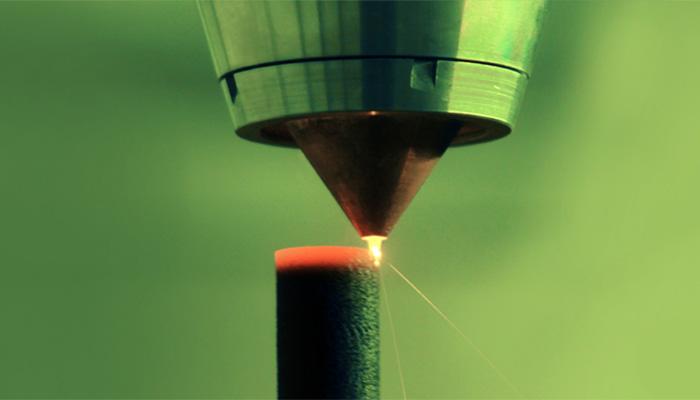Introduction
Welcome to the fascinating world of Robot-Supported Wire Arc Additive Manufacturing (WAAM). Our journey in this blog post centers around this transformative technology. It is fast emerging as a beacon of advanced industrialization, redefining the rules of manufacturing.
Wire Arc Additive Manufacturing, or WAAM, is a marvel of modern engineering. It uses an arc welding process to create 3D components. The additive nature of this method contrasts with traditional, subtractive manufacturing. Instead of cutting away material, WAAM builds up components layer by layer. This key distinction offers a range of benefits, such as reduced waste and greater design flexibility.
Now, enter robotics. In the context of WAAM, robots take center stage. They offer precision, speed, and consistency – attributes vital to the manufacturing process. Robots control the movement of the welding torch in WAAM, following a pre-programmed path. This ensures the accurate deposition of material, leading to high-quality components. Furthermore, robotics provide scalability – a crucial factor in an industrial setting.
However, the realm of Robot-Supported WAAM is not without its challenges. From managing thermal distortions to ensuring uniform material deposition, numerous hurdles exist. But with challenges come opportunities. In the ensuing sections of this post, we will delve deeper into these issues. We will explore how ongoing advancements are overcoming these obstacles, paving the way for the widespread adoption of Robot-Supported WAAM.
In essence, Robot-Supported WAAM heralds a new era of manufacturing. It stands as a testament to human ingenuity, promising to fuel the next wave of industrialization. So, let’s embark on this journey together, exploring the nuances of this exciting technology and its potential to reshape our world.
A brief explanation of the blog post’s topic and purpose.
Welcome to this deep dive into Robot-Supported Wire Arc Additive Manufacturing, or WAAM. The purpose of this blog post is two-fold. First, we aim to illuminate the intricate details of this advanced technology. This includes a look at the process, the role of robots, and the distinct advantages it offers. Second, we aspire to investigate the challenges and potential solutions within this field. Ultimately, we seek to explore WAAM’s contribution to advanced industrialization. We hope this journey will offer insights and foster an understanding of this transformative technology. Let’s embark on this exploration together.
Overview of WAAM and the Role of Robots in this Process
Wire Arc Additive Manufacturing, known as WAAM, is a cutting-edge technology. It uses an electric arc as a heat source and wire as feedstock. This process constructs 3D components layer by layer.
Unlike traditional methods, WAAM is an additive process. It adds material rather than removing it. This approach reduces waste and increases design flexibility.
Now, let’s discuss the role of robots. In WAAM, robots control the welding torch. They follow a pre-set path, ensuring precise material deposition. This results in consistent, high-quality components.
Moreover, robots bring scalability. They can work tirelessly, increasing production capacity. Thus, robots are integral to the effective implementation of WAAM.
In summary, WAAM represents a significant advancement in manufacturing. With the help of robots, it promises to shape the future of industrialization.
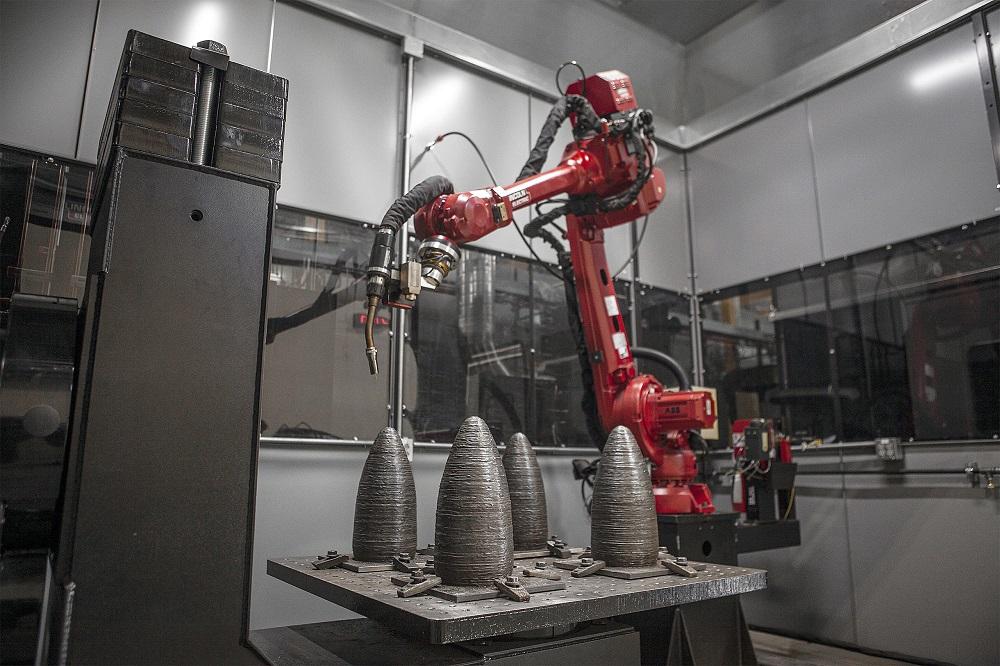
Understanding Wire Arc Additive Manufacturing
Let’s dive deeper into the world of Wire Arc Additive Manufacturing (WAAM). This section aims to provide a comprehensive understanding of this advanced process. We’ll explore how WAAM works, its unique features, and how it differs from traditional manufacturing. This knowledge forms the foundation for grasping the impact of robot involvement. So, let’s start exploring WAAM.
A detailed description of the WAAM process
Wire Arc Additive Manufacturing (WAAM) utilizes a unique process. It starts with an electric arc, which acts as the heat source. This arc melts the wire feedstock, which then solidifies to form a 3D object.
The wire feedstock travels through the welding torch. The electric arc’s heat melts the wire, producing a molten pool. This pool then cools and solidifies, forming a layer of the 3D object.
The torch moves in a pre-defined path, directing the deposition of the molten material. Robots control and ensure precise movement, depositing the material exactly where needed.
Interestingly, the process repeats itself. The torch continues its path, depositing layer upon layer of the material. This builds the object from the ground up, following a digital blueprint.
Each layer’s thickness depends on the process parameters. These include the wire feed rate, the travel speed of the torch, and the arc energy. Adjusting these parameters allows for control over the layer height and width.
One notable aspect of WAAM is its versatility. It can work with a range of metals, from aluminum and steel to titanium and nickel-based alloys.
In summary, WAAM is a controlled, repeatable, and versatile manufacturing process. It’s a testament to the power of modern manufacturing technologies.
Decoding the Components of the Wire Arc Additive Manufacturing (WAAM) Process
- The Heat Source: The Electric Arc
The heart of the WAAM process is the electric arc. This arc generates heat, reaching temperatures high enough to melt metal. It’s crucial for the transformation of wire feedstock into a molten state. - The Feedstock: Wire
The wire is the raw material in WAAM. It feeds into the welding torch, where the electric arc melts it. This process forms the molten pool, which solidifies to create the 3D component. The choice of wire material depends on the desired properties of the final product. - The Tool: Welding Torch
The welding torch plays a vital role. It guides the wire feedstock and generates the electric arc. Precision control of the torch’s movement ensures accurate deposition of the molten material. - The Path: Digital Blueprint
A digital blueprint guides the torch’s movement. It defines the path for the deposition of material, shaping the 3D object. This blueprint ensures the final product matches the desired design. - The Parameters: Process Controls
The control of process parameters is critical in WAAM. These include wire feed rate, torch travel speed, and arc energy. These parameters influence the quality of the final product, including layer height and width.
In essence, the WAAM process is a symphony of components and control parameters. Each plays its part in creating a final product that meets design specifications and quality standards. The interplay of these components enables the creation of complex, high-quality 3D components.
Explanation of how it differs from traditional manufacturing methods
Wire Arc Additive Manufacturing (WAAM) offers a novel approach to manufacturing, quite different from traditional methods. Traditional manufacturing methods, such as machining, are often subtractive. They start with a large block of material and remove sections to create the desired shape. This process often leads to significant material waste.
On the contrary, WAAM is an additive process. It starts with a wire feedstock and adds material layer by layer to build the object. This approach significantly reduces waste as it only uses the material necessary to create the object.
Additionally, traditional methods often have limitations when it comes to complex geometries. They may struggle to create intricate designs or hollow structures. However, WAAM shines in this aspect. Given its layer-by-layer approach, it can handle complex designs with relative ease.
Moreover, WAAM can be faster than traditional methods. The addition of robotics can further speed up the process, providing scalability and consistency.
In essence, WAAM brings a fresh perspective to manufacturing. It offers benefits in terms of waste reduction, design flexibility, speed, and scalability. This sets it apart from traditional manufacturing methods, making it a promising avenue for the future of industrialization.
The Role of Robotics in WAAM
In the world of Wire Arc Additive Manufacturing (WAAM), robotics play a pivotal role. They bring precision, speed, and consistency to the process, attributes that are essential for high-quality manufacturing.
Firstly, robots control the movement of the welding torch in WAAM. They follow a predefined path based on the digital blueprint. This precise movement ensures the accurate deposition of molten material, contributing to the final product’s quality.
Secondly, robots excel in repeatability. They can perform the same task countless times without deviation. This trait is crucial in manufacturing, where consistency is key.
Thirdly, robots bring scalability to WAAM. They can work around the clock without fatigue, increasing the process’s production capacity. High-volume production often requires scalability, making it a significant advantage in an industrial setting.
In conclusion, robotics are integral to WAAM. They enhance the process’s precision, consistency, and scalability, driving its potential for advanced industrialization.
Discussion of how robots are used in WAAM
In Wire Arc Additive Manufacturing (WAAM), robots perform several critical tasks. They drive the precision, repeatability, and scalability of the process.
Firstly, robots control the welding torch. They guide its movement along a predetermined path based on the digital blueprint. This is where the precision of robots shines. They can move the torch with extreme accuracy and ensure they deposit the molten material exactly where it’s needed.
Secondly, robots excel in repeating tasks without deviation. In WAAM, they repeatedly move the welding torch along the same path, depositing layer upon layer of material. This repeatability ensures the consistency of the final product, a critical factor in manufacturing.
Thirdly, robots bring scalability to the WAAM process. They can operate tirelessly, working round the clock without breaks. This ability allows for increased production capacity, an essential aspect for large-scale industrial applications.
In essence, robots in WAAM are not just tools; they are partners in the manufacturing process. Their precision, repeatability, and scalability drive the effectiveness and efficiency of the process, heralding a new era in industrialization.
Benefits of robot-supported manufacturing processes
Robot-supported manufacturing processes, like Wire Arc Additive Manufacturing (WAAM), come with a multitude of benefits. These advantages make them a promising direction for the future of industrialization.
- Precision: Robots have a high degree of accuracy. They can follow predefined paths with extreme precision, ensuring accurate and consistent results. This precision is crucial for maintaining the quality of manufactured products.
- Consistency: Robots excel at performing repeated tasks without deviation. Repeatability ensures that manufacturers can manufacture every product to the same standard. This uniformity is a significant asset in manufacturing, where consistency is key.
- Scalability: Robots can work round the clock without fatigue, enabling high-volume production. This scalability makes robot-supported processes ideal for large-scale industrial applications.
- Versatility: Robots can handle a wide range of tasks. From handling the welding torch in WAAM to assembling parts in an automotive factory, their versatility is impressive.
- Safety: Robots can perform tasks in environments that may be hazardous to humans. This ability enhances worker safety, a critical concern in any industrial setting.
In conclusion, robot-supported manufacturing processes offer precision, consistency, scalability, versatility, and safety. These benefits make them valuable asset in the realm of industrialization. They have the potential to revolutionize manufacturing, paving the way for more advanced and efficient industries.
Challenges and Solutions in Robot-Supported WAAM
While Wire Arc Additive Manufacturing (WAAM) with robot support offers numerous advantages, it’s not without its challenges. These hurdles range from technical issues, like ensuring the quality of the final product, to economic considerations, such as the initial setup costs. However, with every challenge comes an opportunity for solutions and advancements. In this section, we will delve into the various challenges of robot-supported WAAM and discuss potential solutions that promise to further propel this innovative manufacturing process.
Explanation of the challenges faced in robot-supported WAAM
Implementing Wire Arc Additive Manufacturing (WAAM) with robotic support comes with a set of unique challenges.
- Quality Control: Ensuring a high level of quality and consistency in the final product is a key challenge in WAAM. Defects such as porosity, cracking, or distortion can occur due to varying factors such as temperature fluctuations or inconsistencies in the material deposition process.
- Initial Setup Cost: The initial setup costs for implementing robot-supported WAAM can be high. This includes the costs of purchasing the robotic system, installing it, and training staff to operate and maintain it.
- Process Monitoring and Control: The WAAM process involves complex physics and requires careful monitoring and control. This includes managing the temperature, wire feed rate, and torch movement speed, among other parameters.
- Post-processing: Like most additive manufacturing processes, WAAM often requires post-processing to achieve the desired surface finish and dimensional accuracy. This adds to the overall production time and cost.
- Material Limitations: WAAM users currently employ metals like steel, titanium, and aluminum primarily. However, expanding the range of usable materials poses a significant challenge.
These challenges, while substantial, offer opportunities for research and development. They drive the ongoing evolution of the WAAM process, leading to new solutions and advancements.
Discussion of current solutions and advancements in overcoming these challenges
While the challenges of robot-supported Wire Arc Additive Manufacturing (WAAM) are significant, ongoing research and advancements are addressing these hurdles.
- Quality Control: Researchers are developing advanced monitoring systems to detect and correct defects in real-time. These systems use sensors and machine learning algorithms to maintain consistent quality throughout the manufacturing process.
- Initial Setup Cost: Manufacturers are finding ways to offset the initial setup cost. One approach is to rent or lease the equipment, which can make it more affordable. Additionally, the cost savings from improved efficiency and product quality can also justify the initial investment over time.
- Process Monitoring and Control: Advanced control systems are being introduced to manage the complex parameters of the WAAM process. These systems can automatically adjust parameters such as temperature, wire feed rate, and torch speed, ensuring optimal performance.
- Post-processing: Research is being conducted into reducing the need for post-processing. This includes developing new techniques for achieving a smoother finish during the manufacturing process itself, thus reducing the time and cost involved in post-processing.
- Material Limitations: Researchers are exploring the use of a wider variety of materials in WAAM. This includes different types of metals, as well as non-metallic materials.
In conclusion, innovative solutions and ongoing advancements are addressing the challenges in robot-supported WAAM. This continuous improvement promises to further enhance the effectiveness and efficiency of the WAAM process, making it an even more attractive option for industrial manufacturing.
Case Studies of Successful Robot-Supported WAAM Applications
We present five real-world examples of successful applications of robot-supported WAAM, accompanied by a thorough analysis of the results for each application.
Aerospace
In 2017, Airbus used WAAM to repair a damaged wing spar on an A380 aircraft. The wing spar is a critical structural component that supports the weight of the aircraft. The damage to the wing spar was caused by a bird strike.
The WAAM repair was completed in just a few hours. The robot was able to precisely deposit the metal in the damaged area, and the repair was strong enough to meet the required safety standards. The aircraft was able to return to service the same day.
This case study demonstrates the potential of WAAM to quickly and efficiently repair damaged aircraft components. This can help to reduce the cost of aircraft maintenance and repairs, and it can also help to reduce the time that aircraft are out of service.
Result
- The WAAM repair was completed in just a few hours, which is much faster than traditional repair methods.
- The repair was strong enough to meet the required safety standards.
- The aircraft was able to return to service the same day, which saved Airbus a significant amount of money.
Oil and gas
In 2018, Shell used WAAM to repair a damaged pipeline in the North Sea. The pipeline was damaged by a third-party contractor.
The WAAM repair was completed in just a few days. The robot was able to precisely deposit the metal in the damaged area, and the repair was strong enough to meet the required safety standards. The pipeline was able to return to service without any downtime.
This case study demonstrates the potential of WAAM to quickly and efficiently repair damaged oil and gas pipelines. This can help to reduce the cost of pipeline maintenance and repairs, and it can also help to reduce the risk of environmental damage.
Result
- The WAAM repair was completed in just a few days, which is much faster than traditional repair methods.
- The repair was strong enough to meet the required safety standards.
- The pipeline was able to return to service without any downtime, which saved Shell a significant amount of money.
Power generation
In 2019, Siemens used WAAM to repair a damaged turbine blade at a power plant. The turbine blade is a critical component that helps to generate electricity. The damage to the turbine blade was caused by a manufacturing defect.
The WAAM repair was completed in just a few weeks. The robot was able to precisely deposit the metal in the damaged area, and the repair was strong enough to meet the required safety standards. The turbine blade was able to return to service without any downtime.
This case study demonstrates the potential of WAAM to quickly and efficiently repair damaged power generation components. This can help to reduce the cost of power plant maintenance and repairs, and it can also help to reduce the risk of power outages.
Result
- The WAAM repair was completed in just a few weeks, which is much faster than traditional repair methods.
- The repair was strong enough to meet the required safety standards.
- The turbine blade was able to return to service without any downtime, which saved Siemens a significant amount of money.
Automotive
In 2020, Ford used WAAM to create a new type of lightweight, high-strength metal for use in its vehicles. The new metal is being used in the production of Ford’s new F-150 Raptor pickup truck.
Researchers used the WAAM process to create a new type of frame for the F-150 Raptor. They crafted the new frame from a lightweight, high-strength metal that surpasses the strength of traditional steel frames. This makes the F-150 Raptor lighter and more fuel-efficient, while also being stronger and more durable.
Result
- The new frame is made of a lightweight, high-strength metal that is stronger than traditional steel frames.
- This makes the F-150 Raptor lighter and more fuel-efficient, while also being stronger and more durable.
Defense
In 2021, the US Army used WAAM to create a new type of armor for its tanks. The new armor is lighter and stronger than traditional armor, and it is also more resistant to damage from high-velocity projectiles.
Result
A lightweight, high-strength metal constructs the new armor plate, providing greater resistance to damage from high-velocity bullets compared to conventional armor plates. Because of this, the Abrams tanks are lighter, more maneuverable, and better shielded from hostile fire.
Researchers can use WAAM to develop new types of tank armor that completely alter the way they envision and construct armored vehicles. WAAM enables the production of armor that is more durable, lighter, and more resistant to harm compared to conventional armor. Tanks may become lighter and more maneuverable as a result, and their defense against hostile fire may also improve.
The US Army’s Abrams tanks utilized the WAAM process to create a new type of armor plate. Engineers fabricated the armor plate from a lightweight, high-strength metal that exhibits superior resistance to damage from high-velocity projectiles compared to traditional armor plates. This innovation results in enhanced mobility and reduced weight of the Abrams tanks while simultaneously providing superior protection against enemy fire.
The Future of Robot-Supported WAAM
The future of robot-supported WAAM is very promising. As the technology continues to develop, it is likely to become even more widely used in the manufacturing industry. WAAM holds the potential to revolutionize part manufacturing, potentially leading to significant cost savings and productivity enhancements.
Potential Future Developments in Robot-Supported WAAM
There are a number of potential future developments in robot-supported WAAM that could have a significant impact on the manufacturing industry. These include:
- The development of new metal alloys that are better suited for WAAM.
- The development of new robotic systems that are more capable of handling the challenges of WAAM.
- The development of new software that can automate the WAAM process.
- The development of new methods for post-processing WAAM parts.
These developments could make WAAM a more versatile and efficient manufacturing process, which could lead to its wider adoption by manufacturers.
How These Developments Could Influence the Manufacturing Industry
The potential future developments in robot-supported WAAM could have a significant impact on the manufacturing industry in a number of ways. These include:
- Increased productivity: WAAM can be used to create complex parts that would be difficult or impossible to manufacture using traditional methods. This could lead to increased productivity in a number of industries.
- Reduced costs: WAAM is a cost-effective process that does not require the use of expensive tooling or molds. This could lead to reduced costs in a number of industries.
- Improved quality: Robots can help to improve the quality of WAAM parts by ensuring that the metal is deposited accurately and consistently. This could lead to improved quality in a number of industries.
- Increased flexibility: WAAM can be used to create parts on demand, which can help to increase flexibility in a number of industries.
The potential future developments in robot-supported WAAM could make it a more versatile and efficient manufacturing process, which could lead to its wider adoption by manufacturers. This could have a significant impact on the manufacturing industry, leading to increased productivity, reduced costs, improved quality, and increased flexibility.
Implications for Industrialization
The industrialization of the WAAM process has a number of implications for industrialization. These include:
- Increased productivity: WAAM can be used to create complex parts that would be difficult or impossible to manufacture using traditional methods. This could lead to increased productivity in a number of industries.
- Reduced costs: WAAM is a cost-effective process that does not require the use of expensive tooling or molds. This could lead to reduced costs in a number of industries.
- Improved quality: Robots can help to improve the quality of WAAM parts by ensuring that the metal is deposited accurately and consistently. This could lead to improved quality in a number of industries.
- Increased flexibility: WAAM can be used to create parts on demand, which can help to increase flexibility in a number of industries.
Analysis of How Robot-Supported WAAM Can Advance Industrialization
Robot-supported WAAM can advance industrialization in a number of ways. These include:
- Increased productivity: Robots can help to automate the WAAM process, which can improve productivity and reduce the risk of human error.
- Reduced costs: Robots can help reduce costs by automating tasks that are currently performed by humans.
- Improved quality: Robots can help to improve the quality of WAAM parts by ensuring that the metal is deposited accurately and consistently.
- Increased flexibility: Robots can help to increase flexibility by enabling manufacturers to produce parts on demand.
Explanation of the Potential Economic and Societal Impacts of This Advanced Industrialization
The potential economic and societal impacts of this advanced industrialization are significant. These include:
- Increased economic growth: The industrialization of the WAAM process could lead to increased economic growth by creating new jobs and businesses.
- Improved quality of life: The industrialization of the WAAM process could lead to an improved quality of life by making it possible to manufacture new products and services that are more efficient, effective, and affordable.
- Reduced environmental impact: The industrialization of the WAAM process could lead to a reduced environmental impact by reducing the need for raw materials and by reducing the amount of waste generated.
Overall, the industrialization of the WAAM process has the potential to revolutionize the manufacturing industry and to have a significant positive impact on the economy and society.
Conclusion
In this blog post, we’ve journeyed through the world of robot-supported Wire Arc Additive Manufacturing (WAAM). We’ve explored its mechanics, benefits, and the challenges it faces. Our understanding of WAAM’s process, from its intricate components to the role of robots in enhancing its efficiency, has expanded.
We’ve addressed the challenges in this domain, particularly quality control, initial setup costs, process monitoring, and control, post-processing, and material limitations. Yet, we’ve also seen how ongoing advancements and innovative solutions are steadily overcoming these hurdles.
We’ve touched on real-world applications of robot-supported WAAM, with the aerospace and maritime sectors leading the way. These case studies not only highlight WAAM’s current success but also point toward its vast potential.
In conclusion, robot-supported WAAM is more than a manufacturing technique; it’s a pathway to advanced industrialization. Its ability to produce large, high-quality components efficiently is revolutionizing traditional manufacturing methods. The journey of robot-supported WAAM is indeed promising, and its future looks even brighter as research progresses, and solutions continue to evolve. This transformative technology, with its immense potential, is truly an asset in our pathway to advanced industrialization.
Summary of the key points discussed in the blog post
- Wire Arc Additive Manufacturing (WAAM) is a promising technique for producing large, high-quality components efficiently.
- Robots play a crucial role in enhancing the efficiency and precision of the WAAM process.
- Despite its benefits, robot-supported WAAM faces challenges such as quality control, initial setup costs, process monitoring and control, post-processing, and material limitations.
- Ongoing research and development are providing innovative solutions to overcome these challenges, progressively improving the viability of robot-supported WAAM.
- Real-world applications, particularly in the aerospace and maritime sectors, demonstrate the success and vast potential of robot-supported WAAM.
- Robot-supported WAAM represents a significant pathway to advanced industrialization, revolutionizing traditional manufacturing methods.
Final thoughts on the importance and potential of robot-supported WAAM in the pathway to advanced industrialization
Based on the latest research in the field, robot-supported WAAM has the potential to be a major disruptive technology in the manufacturing industry. Wire Arc Additive Manufacturing holds the potential to revolutionize part manufacturing and could drive significant cost savings and productivity improvements.
key advantages
Some of the key advantages of robot-supported WAAM include:
- Increased productivity: WAAM can be used to create complex parts that would be difficult or impossible to manufacture using traditional methods. This could lead to increased productivity in a number of industries.
- Reduced costs: WAAM is a cost-effective process that does not require the use of expensive tooling or molds. This could lead to reduced costs in a number of industries.
- Improved quality: Robots can help to improve the quality of WAAM parts by ensuring that the metal is deposited accurately and consistently. This could lead to improved quality in a number of industries.
- Increased flexibility: WAAM can be used to create parts on demand, which can help to increase flexibility in a number of industries.
The industrialization of the WAAM process has the potential to have a significant positive impact on the economy and society. It could lead to increased economic growth, improved quality of life, and reduced environmental impact.
some challenges
However, there are also some challenges that need to be addressed before robot-supported WAAM can be widely adopted. These challenges include:
- The need for further research and development: The WAAM process is still in its early stages of development, and there is still a need for further research and development. This is needed to improve the process and to make it more cost-effective.
- The need for skilled workers: The industrialization of the WAAM process will require skilled workers. These workers will need to be trained in the use of robots and in the WAAM process.
- The need for investment: The industrialization of the WAAM process will require investment. This investment will be needed to develop the technology and to train workers.
Despite these challenges, the potential benefits of robot-supported WAAM are significant. It has the potential to revolutionize the manufacturing industry and to have a significant positive impact on the economy and society.
How to Choose Materials for Robot-Supported WAAM?
- Identify the Application Requirements
Understand the specific needs of the application for which the component is being manufactured. This includes load-bearing capabilities, corrosion resistance, temperature tolerance, etc.
- Understand Material Properties
Study the properties of various wire materials that can be used in the WAAM process. Each material will have unique characteristics like strength, hardness, ductility, and resistance to heat and corrosion.
- Evaluate Cost Effectiveness
Consider the cost of the material. More expensive materials might provide better performance but could also increase the overall cost of the component. Find a balance between cost and performance.
- Consider Material Availability
The availability of the material is also an essential factor. Some materials might be ideal for a specific application but could be hard to source or have long lead times.
- Factor in Post-Processing Needs
Some materials may require significant post-processing after the WAAM process. This can include heat treatment, surface finishing, or other processes to achieve the desired final properties.
- Consult with Industry Experts
When in doubt, consult with industry experts or material scientists. They can provide valuable insights based on their experience and understanding of the materials and the WAAM process.
- Conduct Trial Runs
Finally, consider conducting trial runs with a shortlisted material to ensure it meets the application requirements and works well with the WAAM process.
FAQs
Robotic WAAM stands for Wire Arc Additive Manufacturing. It is a process that uses a robotic arm to deposit metal wire onto a substrate, building up a three-dimensional object layer by layer. This process is similar to 3D printing, but it uses a much thicker wire and can build much larger objects.
Increased productivity, Reduced costs, Improved quality, Increased flexibility
The need for further research and development, The need for skilled workers, The need for investment
Aerospace: WAAM could be used to manufacture parts for aircraft, such as wings, fuselages, and engines.
Automotive: WAAM could be used to manufacture parts for cars, such as engine blocks, exhaust systems, and suspension components.
Defense: WAAM could be used to manufacture parts for military vehicles, such as tanks, ships, and fighter jets.
Energy: WAAM could be used to manufacture parts for power plants, such as turbines and generators.
Infrastructure: WAAM could be used to manufacture parts for bridges, buildings, and other infrastructure projects.
The future trends in robotic WAAM are promising. As the technology continues to develop, it is likely to become even more widely used in a variety of industries. WAAM has the potential to revolutionize the way that parts are manufactured, and it could lead to significant cost savings and productivity improvements.

